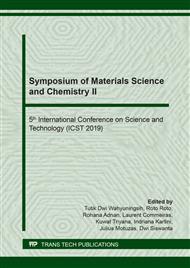[1]
D. Dong, D. Li, Y. Wu, C.-Z. Li, H. Wang, Synthesis of cathode materials for solid oxide fuel cells with eggshell membrane as template, Chemeca 2010: Engineering at the Edge, 26-29 September 2010, Hilton Adelaide, Australia.
Google Scholar
[2]
B. Hosseini, S.M. Mirhadi, M. Mehrazin, M. Yazdanian, M.R.K. Motamedi, Synthesis of nanocrystalline hydroxyapatite using eggshell and trimethyl phosphate, Trauma Mon. 22 (2017) 1-7.
DOI: 10.5812/traumamon.36139
Google Scholar
[3]
A. Hussain, Dielectric properties and microwave assisted separation of eggshell and membrane, Thesis, McGill University, (2009).
Google Scholar
[4]
S.M. Naga, H.F. Al-Maghraby, M. Sayed, E.A. Saad, Highly porous scaffolds made of nanosized hydroxyapatite powder synthesized from eggshells, J. Ceram. Sci. Tech. 6 (2015) 237-244.
Google Scholar
[5]
Jamila, Pemanfaatan Limbah Cangkang Telur, (2014).
Google Scholar
[6]
S.C. Wu, H.C. Hsu, S.K. Hsu, Y.C. Chang, W.F. Ho, Effects of heat treatment on the synthesis of hydroxyapatite from eggshell powders, Ceram. Int. 41 (2015) 10718-10724.
DOI: 10.1016/j.ceramint.2015.05.006
Google Scholar
[7]
G. S. Bumbrah, R. M. Sharma, Raman spectroscopy-basic principle, instrumentation and selected applications for the characterization of drugs of abuse, Egyptian J. Forensic Sci. 6 (2016) 209-215.
DOI: 10.1016/j.ejfs.2015.06.001
Google Scholar
[8]
N. Mironova-Ulmane, A. Kuzmin, M. Grube, Raman and infrared spectromicroscopy of manganese oxides, J. Alloys Compd. 480 (2009) 97-99.
DOI: 10.1016/j.jallcom.2008.10.056
Google Scholar
[9]
I. Sopyan, M. Arianti, A.A. Alhamidi, Development of hydroxyapatite powder for medical application: preliminary characterization using FTIR and XRD, Prosiding Pertemuan Ilmiah Ilmu Pengetahuan dan Teknologi Bahan 2002, 22-23 Oktober 2002, Serpong, pp.199-204.
Google Scholar
[10]
C.G. Kontoyannis, N.V. Vagenas, Calcium carbonate phase analysis using XRD and FT-Raman spectroscopy, Analyst 125 (2000) 251-255.
DOI: 10.1039/a908609i
Google Scholar
[11]
J. A. Razak, S. Sufian, K.Z.K Shaari, P. Puspitasari, T.M. Hoe, N. Yahya, Synthesis, characterization and application of Y3Fe5O12 nanocatalyst for green production of NH3 using magnetic induction method (MIM), AIP Conf. Proc. 1482 (2012) 633-638.
DOI: 10.1063/1.4757548
Google Scholar
[12]
P. Risdanareni, P. Puspitasari, E. J. Jaya, Chemical and physical characterization of fly ash as geopolymer material, MATEC Web of Conferences 97 (2017) 1-8.
DOI: 10.1051/matecconf/20179701031
Google Scholar
[13]
P. Puspitasari, J. Abd. Razak, N. Yahya, Ammonia synthesis using magnetic induction method (MIM), AIP Conf. Proc. 1482 (2012) 605-610.
DOI: 10.1063/1.4757543
Google Scholar
[14]
R. Ševčík, P. Mácová, Localized quantification of anhydrous calcium carbonate polymorphs using micro-Raman spectroscopy, Vib. Spectrosc. 95 (2018) 1-6.
DOI: 10.1016/j.vibspec.2017.12.005
Google Scholar
[15]
W. Kaabar, S. Bott, R. Devonshire, Raman spectroscopic study of mixed carbonate materials, Spectrochim. Acta A Mol. Biomol. Spectrosc. 78 (2011) 136-141.
DOI: 10.1016/j.saa.2010.09.011
Google Scholar
[16]
L. J. Bonales, V. Muñoz-Iglesias, D. Santamaría-Pérez, M. Caceres, D. Fernandez-Remolar, O. Prieto-Ballesteros, Quantitative Raman spectroscopy as a tool to study the kinetics and formation mechanism of carbonates, Spectrochim. Acta A Mol. Biomol. Spectrosc. 116 (2013) 26-30.
DOI: 10.1016/j.saa.2013.06.121
Google Scholar
[17]
F.B. Reig, J.V.G. Adelantado, M.C.M.M. Moreno, FTIR quantitative analysis of calcium carbonate (calcite) and silica (quartz) mixtures using the constant ratio method. application to geological samples, Talanta 58 (2002) 811-821.
DOI: 10.1016/s0039-9140(02)00372-7
Google Scholar
[18]
M.B. Toffolo, L. Regev, S. Dubernet, Y. Lefrais, E. Boaretto, FTIR-based crystallinity assessment of aragonite–calcite mixtures in archaeological lime binders altered by diagenesis, Minerals 9 (2019) 1-14.
DOI: 10.3390/min9020121
Google Scholar


